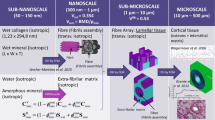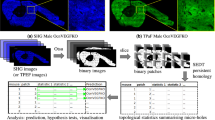Summary
Optical Fourier analysis was applied for evaluation of the differences between normal and pathologically changed bone tissue. Collagen fibers were used as markers of bone structure. To prove the usefulness of this technique for objective mathematical analysis of these differences the spatial distribution of collagen fiber bundles was evaluated in normal and osteopetrotic bone. The variation in the spatial distribution of collagen fiber bundles in cross sections of femur diaphyses was evaluated quantitatively by optical diffraction in three groups of Fatty Orl-op strain rats, i.e. phenotypically normal animals, osteopetrotic (op/op) mutants and op/op-mutants cured by transplantation of normal syngenic bone marrow. The histological sections of decalcified bone were stained with Sirus-Red and then photographed under polarizing microscope. The Sirus-Red staining was used to enhance the natural birefringency of collagen fibers. Diffractograms obtained from microphotographs of selected bone section areas, i.e. outer and inner circumferential lamellae and haversian bone of normal and cured op/op animals as well as whole cortical bone and woven bone filling the medullary cavities in op/op mutants were analysed separately. Diffractograms contain summarized information on the size and relative position of histological structures. The radial distribution of light energy informs on the size and/or distances between the structures, while angular distribution gives the relative position of these structures in histological sections. The radial and angular distribution of light energy were evaluated for each diffractogram with an electronic detector. The obtained distributions were described by several sets of parameters concerning the position, level and shape of local maxima and minima. Out of these parameters five with the highest discriminant power were chosen for further mathematical analysis. This analysis was based on the calculation of the position of centroids in the multidimensional space described by the linear functions of the chosen parameters for each of the evaluated bone section areas. The centroids (mean values of discriminant scores of each group) represent the centers of gravity of the analysed groups, while the separation of the centroids tested by the F-test illustrates the differences between the respective groups of selected bone section areas. A high level of separation of centroids was found when osteopetrotic bone was compared with normal one, what means that the spatial distribution, size and interstructural distances between the collagen fiber bundles in bone tissue in these two groups of animals differ markedly. A similar situation was observed when osteopetrotic bone was compared with bone tissue obtained from op/op mutants cured by transplantation of normal syngenic bone marrow. On the other hand, the level of separation of centroids was low when bone tissue of cured op/op mutants was compared with the control one, a finding which corresponds to the less pronounced histological differences between these two groups of animals. Computer-aided classification on single microphotographs of selected bone section areas to the known a priori type of bone tissue was performed. The percentage of cases correctly classified to one of the eight groups of selected bone section areas equals 47. The probability of reaching such a result by chance was estimated as less than 10−4. The percentage of cases classified correctly to one of any two statistically different groups was higher than 90. These observations demonstrate that optical diffractometry allows to describe in numerical terms the differences between normal and pathologically changed bone tissue, and therefore might be used for automatic evaluation of histopathological sections and interlaboratory comparative studies.
Similar content being viewed by others
References
Ahrens H, Läuter J (1974) Mehrdimensionale Varianzanalyse. Akademie Verlag, Berlin
Cooley WW, Lohnes PR (1971) Multivariante data analysis. Wiley Interscience, New York
Currey JD (1955) Three analogies to explain the mechanical properties of bone. Biorheology 2:1–10
Currey JD (1962) Strength of bone. Nature 195:513–514
Dziedzic-Goclawska A, Ostrowski K, Michalik J, Stachowicz W, Moutier R, Toyama K, Lamendin H (1979) Decrease of the crystallinity of bone mineral in osteopetrotic rats. Metab Bone Dis Rel Res 2:33–37
Engfeld B, Engström A, Zetterström R (1954) Biophysical studies on bone tissue. III Osteopetrosis. Marble bone disease. Acta Paediat 43:152–162
Engfeldt B, Engström A, Zetterström R (1960) Biophysical studies on bone tissue. III. Roentgenological and pathologic-anatomical investigations on some bone changes. Acta Paediat 49:391–408
Junqueira LCU, Bignolas G, Brentani RR (1979) Picrosirius staining plus polarizing microscopy, a specific method for collagen detection in tissue sections. Histochem J 11:447–455
Klecka WR (1975) Discriminant analysis. In: Statistical Package for the Social Sciences. McGraw Hill, New York, pp 434–467
Lenczowski S, Różycka M, Sawicki W, Daszkiewicz M, Barańska W, Dziedzic-Goclawska A, Ostrowski K (1980) Microscopic image analysis by the optical Fourier transform. Materia Medica Polona 12:272–285
Marks SC, Walker DG (1976) Mammalian osteopetrosis a model for studying cellular and humoral factors in bone resorption. In: Bourne GH (ed) The biochemistry and physiology of bone. 2nd edit, vol 4. Academic Press, New York, pp 227–301
Milhaud G, Labat ML, Graf B, Juster MM, Balmain M, Moutier R, Toyama K (1975) Démonstration cinétique, radiologique et histologique de la guerison de l'ostéopétrose congénitale du rat. CR Acad Sci Paris Ser D 280:2484
Milhaud G, Labat ML (1978) Thymus and osteopetrosis. Clin Orthop 135:260–271
Moutier R, Lamendin H, Bérenholc S (1973) Ostéopétroses par mutation spontanée chez le rat. Exp Anim 6:87–101
Moutier R, Toyama K, Charrier MF (1974) Genetic study of osteopetrosis in the Norway rat. J Heredity 65:373–375
Moutier R, Toyama K, Cotton WR, Gaines JF (1976) Three recessive genes for congenital osteopetrosis in the Norway rat. J Hered 67:189–190
Moutier R, Ballet JJ, Lamendin H, Toyama K, Bérenholc S (1978) Recherches pour une résorption osseuse chez l'homme ostéopétrotique. Symbiose 10:127–129
Pernick B, Kopp RE, Lisa J, Mendelsohn J, Stone H, Wohlers R (1978) Screening of cervical cytological samples using coherent optical processing. Appl Opt 17:21–42
Walker DG (1975a) Bone resorption restored in osteopetrotic mice by transplants of normal bone marrow and spleen cells. Science 190:784–785
Walker DG (1975b) Spleen cells transmit osteopetrosis in mice. Science 190:785–786
Author information
Authors and Affiliations
Rights and permissions
About this article
Cite this article
Dziedzic-Goclawska, A., Rozycka, M., Czyba, J.C. et al. Application of the optical Fourier transform for analysis of the spatial distribution of collagen fibers in normal and osteopetrotic bone tissue. Histochemistry 74, 123–137 (1982). https://doi.org/10.1007/BF00495058
Received:
Issue Date:
DOI: https://doi.org/10.1007/BF00495058




